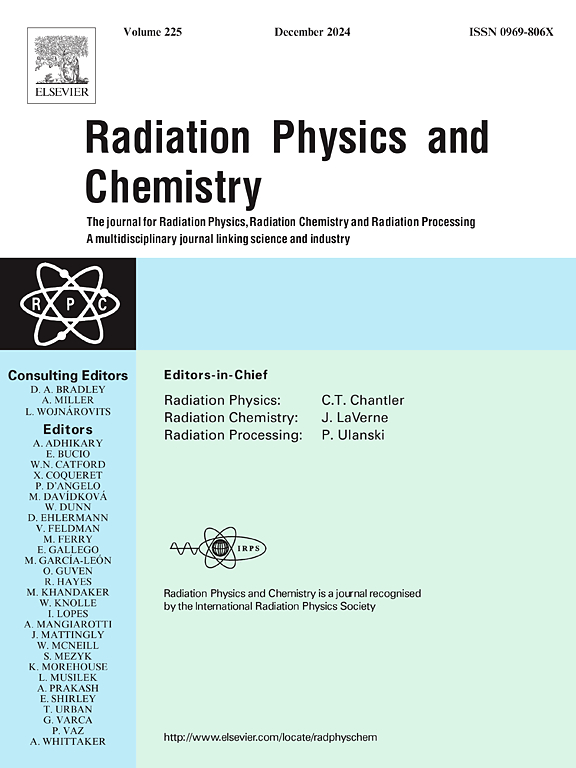辐照改性三苯基膦树脂的合成及高铀背景下低浓度铼异常富集行为的研究
IF 2.8
3区 物理与天体物理
Q3 CHEMISTRY, PHYSICAL
引用次数: 0
摘要
为了回收高铀浸出液背景环境中的痕量铼资源,我们采用电子加速器辐照接枝技术,在苯乙烯氯球骨架表面高密度固化三苯基膦,合成了一种适合在低浓度环境下高效吸附铼的树脂,该树脂可以规避离子交换中的内部扩散过程。并研究了该材料在静态和动态吸附模式下的吸附和解吸性能。通过静态和动态吸附研究了材料的吸附和解吸性能。结果表明,新树脂对pH = 1 ~ 10之间的铼具有良好的富集能力,基本不吸附铀,树脂的饱和吸附容量可达233.58 mg/g,最大铀铼分离系数β (Re/U)为1840.6,动态吸附平衡时间为256 s。利用扫描电镜(SEM)、傅里叶变换红外光谱(FT-IR)、x射线光电子能谱(XPS)和密度泛函理论(DFT)研究了新材料的吸附和解吸效果及其机理。对树脂的吸附和解吸效果及机理进行了表征,动态吸附表明树脂在270 BV(树脂床体积)时达到吸附渗透,在520 BV时达到吸附饱和,饱和渗透比Ve/Vb(饱和点与渗透点体积之比)为1.92,饱和树脂在100 BV时可被4 mol/L NH4SCN完全解吸,较差的树脂可被浓盐酸有效再生。树脂的交换容量可恢复91%以上,具有重要的应用前景。本文章由计算机程序翻译,如有差异,请以英文原文为准。
Synthesis of irradiation-modified triphenylphosphine resins and study of the extraordinary enrichment behaviour of rhenium at low concentrations against a high uranium background
In order to recover the trace rhenium resources in the background environment of high uranium leach solution, we synthesized a resin suitable for the efficient adsorption of rhenium in a low concentration environment by using electron-accelerator irradiation grafting technology and high-density solidification of triphenylphosphine on the surface of styrene chlorine sphere skeleton, which can circumvent the internal diffusion process in ion exchange, and investigated the adsorption and desorption performance of the material in static and dynamic adsorption modes. The adsorption and desorption properties of the materials were investigated by static and dynamic adsorption. It is shown that the new resin has good enrichment ability for rhenium between pH = 1–10 and basically does not adsorb uranium resin saturated adsorption capacity of up to 233.58 mg/g, the maximum uranium-rhenium separation coefficient β (Re/U) is calculated to be 1840.6, the dynamic adsorption equilibrium time of 256 s. Scanning electron microscopy (SEM), Fourier-transform infrared spectroscopy (FT-IR), and X-ray photoelectron spectroscopy (XPS), and density-functional theory (DFT) were applied to investigate the adsorption and desorption effects and mechanisms of the new material. The adsorption and desorption effects and mechanisms were characterized, dynamic adsorption showed that the resin reached adsorption penetration at 270 BV (resin bed volume) and adsorption saturation at 520 BV, with a saturation-to-penetration ratio Ve/Vb (ratio of the saturation point to the penetration point volume) of 1.92, the saturated resin can be completely desorbed by 4 mol/L NH4SCN at 100 BV, and the poor resin can be effectively regenerated by concentrated hydrochloric acid, and the exchange capacity of the resin can be restored over 91%, which has an important application prospect.
求助全文
通过发布文献求助,成功后即可免费获取论文全文。
去求助
来源期刊

Radiation Physics and Chemistry
化学-核科学技术
CiteScore
5.60
自引率
17.20%
发文量
574
审稿时长
12 weeks
期刊介绍:
Radiation Physics and Chemistry is a multidisciplinary journal that provides a medium for publication of substantial and original papers, reviews, and short communications which focus on research and developments involving ionizing radiation in radiation physics, radiation chemistry and radiation processing.
The journal aims to publish papers with significance to an international audience, containing substantial novelty and scientific impact. The Editors reserve the rights to reject, with or without external review, papers that do not meet these criteria. This could include papers that are very similar to previous publications, only with changed target substrates, employed materials, analyzed sites and experimental methods, report results without presenting new insights and/or hypothesis testing, or do not focus on the radiation effects.
 求助内容:
求助内容: 应助结果提醒方式:
应助结果提醒方式:


